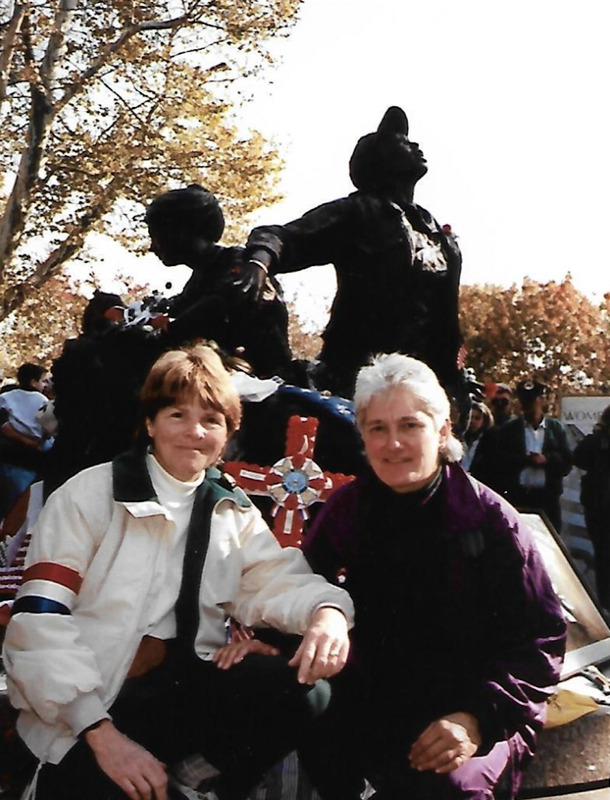“Thats How We Survived” | Resilience, Community, and Intolerance in the Lives of LGBTQ Servicewomen during the Vietnam War era
Digital exhibit by Charlotte Driscoll, Dartmouth College Class of 2021
This exhibit is based on an oral history interview that I conducted with Ms. Kathy Reynolds on November 4, 2020. Ms. Reynolds served in the Vietnam War as an army nurse in the neurosurgical intensive care unit at the 249th General Hospital in Asaka, Japan, between 1968 and 1970. In our conversation, we explored her time in the Army and the major life events that shaped Ms. Reynolds’ worldview. One aspect of her experience stood out to me as particularly deserving of further study; that is her identity as a lesbian woman in the military during a time when LGBT individuals were officially banned from the service.
I hope visitors to my exhibit will come away with the beginnings of an answer to two questions. First, why is it that young gay women would volunteer to go to war on behalf of an institution that was actively hostile to their identity? Second, how did these women survive, and even sometimes thrive, within these settings? Like their straight counterparts, these women simultaneously dealt with wartime traumas and the military’s male-dominated culture. However, unlike their straight counterparts, these women contended with a unique “anti-lesbian apparatus,” as coined by Margot Canaday. I encourage those interested in learning more to consult the literature cited in the bibliography; there is much more to know about the topic than can fit into a single exhibit.
Exhibit Contents
This exhibit focuses on several women’s experiences directly around the time of their service in the Vietnam War era. However, it is crucial to understand that institutional and interpersonal discrimination against LGBT service people continued unabated, and in some cases intensified, through the latter half of the 20th century. This institutional violence continues today, albeit in slightly different forms. Notably, in the 1980s, lesbian women were expelled from the military at a rate far disproportional to their gay male counterparts. In a particularly high profile example, Margarethe Cammermeyer, who entered the Army as a nurse in 1961, served in Vietnam, and progressed to Colonel as Chief Nurse of the Washington State National Guard, was discharged in 1992, having disclosed her sexual identity. The legal battles that followed are representative of LGBT individuals’ struggle for recognition at the time. While female Vietnam veterans gained much deserved formal recognition in 1993 with the dedication of the Vietnam Women’s Memorial, that year also marked the beginning of the Clinton administration’s “Don’t Ask, Don’t Tell” policy, which Cammermeyer considered to be a “travesty.”
Finally, through engaging with the stories I’ve featured, I hope visitors will develop an appreciation for the unique power of oral histories. Alessandro Portelli, whose work changed the way mainstream historians view the field, said, “oral sources tell us not just what people did, but what they wanted to do, and what they believed they were doing, and what they now think they did.” They shed light on the facts that go beyond “materially observable and possibly measurable phenomena.” I have found these ideas to be especially true of the narratives featured here.
In addition to that of Ms. Reynolds, this exhibit will feature the stories of a series of other LGBT Vietnam War-era female veterans. These women are introduced below. See the bibliography page for details on their testimonies.
Judith Crosby: Navy Nurse Corps, 1969-1973
Anna Louise Gerac: Army Nurse Corps, 1966-1971. Ms. Gerac served with Ms. Reynolds at the 249th General Hospital.
Darlene Greenawalt: Army Medical Corps, 1964-1968
Ruth Hughes: Air Force, 1958-1965
"Janice:" Army Nurse Corps, 1960-1962 and 1963-1982
Florence Janisch: Navy Hospital Corps, 1961-1962
Cheryl Marden: Navy Hospital Corps, 1966-1968
Brenda Vosbein: Women's Army Corps, 1970-1975
Citations: Crosby testimony in Estes 2007b; Gerac interview in Dartmouth Vietnam Project Archive; Greeenawalt, Hughes, “Janice,” Janisch and Marden testimonies all in Humphrey 1990; and Vosbein testimony in Estes 2007a.
I want to thank Ms. Reynolds for her generosity in sharing her story with me and for her help throughout this entire process. It has been an honor and pleasure to work with her.
I would also like to thank Professor Miller for his guidance throughout the term, Dr. Laura Braunstein for her help with Omeka-S, Wendel Cox and Professor Moreton for their help finding sources, and, of course, my classmates Sarah Sim, David Velona, and Jay Mortensen.
A note on language
Many of the older sources and oral testimonies referenced in this exhibit refer to LGBT+ individuals using the term "homosexual." Today, this word has been recognized as highly offensive. It carries the American Psychiatric Associations' history of pathologizing "homosexual" individuals as mentally ill or disordered until the 1970s. The Gay and Lesbian Alliance Against Defamation (GLAAD) cites the terms' history of in the rhetoric of anti-gay extremist groups. Please reference the GLAAD Media Guide for further information.

